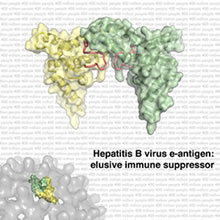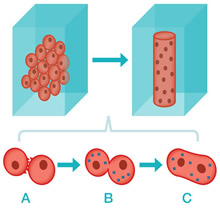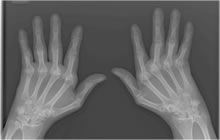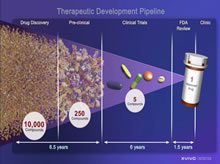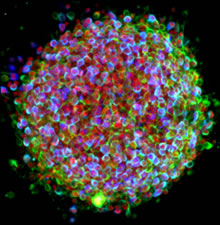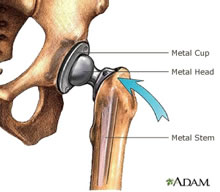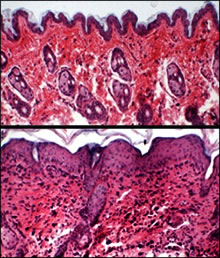Spotlight
Letter from Dr. Stephen I. Katz: Communicating With Congress
Dear Colleagues:
A critical part of the National Institutes of Health (NIH) mission is to keep key stakeholders abreast of the scientific advances, opportunities and challenges that exist in biomedical and behavioral research. It is clear that the discoveries that emerge from NIH-supported laboratories affect the lives of patients and their families, as well as the careers of researchers and clinicians. Ultimately, however, our work belongs to all Americans, which is why it is essential that policymakers, including Members of Congress, are aware of the progress and promise of NIH investments across the country.
Image: Stephen I. Katz, M.D., Ph.D.
News
NIH Scientists Shed Light on Mystery Surrounding Hepatitis B Virus: Discovery Is Decades in the Making
Scientists from the NIAMS, part of the NIH, and the University of Oxford, U.K., have shed light on a long-standing enigma about the structure of a protein related to the hepatitis B virus. Their findings, reported in Structure, could lead to new therapeutic strategies for chronic liver disease.
NIH Study Uncovers Details of Early Stages in Muscle Formation and Regeneration: Mouse Study Findings May Offer Clues for Understanding Cell Fusion
Researchers at the NIH have identified proteins that allow muscle cells in mice to form from the fusion of the early stage cells that give rise to the muscle cells. The findings have implications for understanding how to repair and rehabilitate muscle tissue and for understanding other processes involving cell fusion, such as when a sperm fertilizes an egg, when viruses infect cells or when specialized cells called osteoclasts dissolve and assimilate bone tissue in order to repair and maintain bones.
Genetic Mystery of Behçet’s Disease Unfolds Along the Ancient Silk Road: NIH Researchers Identify New Gene Variants Associated With Risk for Complex Inflammatory Syndrome
Researchers have identified four new regions on the human genome associated with Behçet’s disease, a painful and potentially dangerous condition found predominantly in people with ancestors along the Silk Road. For nearly 2,000 years, traders used this 4,000-mile network linking the Far East with Europe to exchange goods, culture and, in the case of the Silk Road disease, genes. NIH researchers and their Turkish and Japanese collaborators published their findings in the January 6, 2013, advance online issue of Nature Genetics.
Public Access Compliance Monitor: New Web-Based Tool
The NIH announced the release of the Public Access Compliance Monitor, a web-based tool that institutions can use to track compliance of publications that fall under the NIH Public Access Policy. The compliance monitor supports the efforts of grantee organizations to ensure their awards are compliant. For more information, see NIH Guide Notice NOT-OD-13-020.
“My Bibliography” Publications Report for PHS 2590 Now Available With My NCBI
The NIH announced a new enhancement to My NCBI to facilitate reporting of publications in paper progress reports (form PHS 2590). My Bibliography can now generate a PDF report of publications that may be printed and submitted as Section 2.2.6, Section E. Publications, of the paper PHS 2590 progress report. Grantees are encouraged to begin using the PDF report immediately on a voluntary basis, becoming mandatory in spring 2013. For more information, see NIH Guide Notice NOT-OD-13-017.
NIH Director’s Blog
NIH Research Leads to New Rheumatoid Arthritis Drug
About 1.5 million people in the United States suffer from rheumatoid arthritis. It is a chronic illness in which the immune system, which protects us from viral and bacterial invaders, turns on our own body and viciously attacks the membranes that line our joints. The consequences can be excruciating: pain, swelling, stiffness and decreased mobility. Over time, the joints can become permanently contorted, as in this X-ray image.
Image: Copyright (2012) American College of Rheumatology
Tackling the Bottlenecks in the Drug Development Pipeline
The average length of time from target discovery to approval of a new drug currently averages about 14 years? That is WAY too long. Even more shocking is that the failure rate exceeds 95 percent, and the cost per successful drug surpasses $2 billion, after adjusting for all of the failures. The National Center for Advancing Translational Sciences (NCATS) was specifically established one year ago to apply innovative scientific approaches to the bottlenecks in the pipeline.
Why We’re So Excited About Stem Cells
Certainly—as you can see in this image—stem cells are spectacularly beautiful. But they also hold spectacular promise for medicine. That’s why I immediately expressed my enthusiasm for the recent Supreme Court ruling that effectively enables the NIH to continue conducting and funding responsible, scientifically worthy stem cell research.
Other Federal News
Food and Drug Administration (FDA) Safety Communication: Metal-on-Metal Hip Implants
This new information is based on the FDA’s current assessment of metal-on-metal hip implants, including the benefits and risks, the evaluation of the published literature and the results of the June 2012 Orthopaedic and Rehabilitation Devices Advisory Panel meeting.
NEW PUBLICATIONS
February Shorttakes
NIAMS Shorttakes is a compilation of news from the Institute that is published three times a year in conjunction with NIAMS Advisory Council meetings. Scan these items for information on what’s happening at the NIAMS, or access the complete articles for viewing or use in your own newsletter or other publication.
NIH Research Matters
NIH Research Matters is a review of NIH research from the Office of Communications and Public Liaison, Office of the Director, NIH.
Protein Linked to Atopic Dermatitis
A study in mice suggests that lack of a certain protein may trigger atopic dermatitis, the most common type of eczema. The finding may lead to improved treatment options for people.
NIH News in Health
Read practical health information in NIH News in Health, which is reviewed by the NIH’s medical experts and is based on research conducted either by the NIH’s own scientists or by its grantees at universities and medical schools around the country.
Check Up On Your Bones
Are your bones healthy and strong? Learn more about osteoporosis with this interactive web tool. Answer a set of questions, and the site will identify factors that put you at risk for bone loss. This easy-to-use website even suggests ways to improve your bone health.
MEETINGS
Rare Disease Day at NIH
When: Thursday, February 28 from 8:30 a.m. to 5 p.m., and Friday, March 1 from 8:30 a.m. to 4 p.m.
Where: NIH Campus, Natcher Auditorium (Building 45)
Cost: Free
Contact: Dr. David J. Eckstein at the NIH
Available for viewing via NIH videocast
NIH Wednesday Afternoon Lecture Series
The NIH’s Wednesday Afternoon Lecture Series offers weekly lectures every Wednesday at 3 p.m. in Masur Auditorium, Building 10, NIH Campus. Renowned scientists from around the globe present research on a variety of topics. The lectures are continuing medical education certified, open to the public and available live via webcast.
Upcoming lectures:
March 6, 2013
Donald Ingber, Wyss Institute at Harvard
“Organs on Chips and Programmable Nanotherapeutics”
March 13, 2013
The Annual J. Edward Rall Cultural Lecture
Rita Dove, former U.S. Poet Laureate
Lecture title TBA
March 20, 2013
David Sabatini, Whitehead Institute
“Regulation of Growth by the mTOR Pathway”
March 27, 2013
Fred Alt, Harvard University
“Antibodies, Genome Stability and Cancer”
NIH Science Lectures and Events Available Online
The NIH hosts a number of science seminars and events that are available online through real-time streaming video. You can watch an event at your convenience as an on-demand video or a downloadable podcast. Most events are available to all; a few are broadcast for the NIH or the HHS, and are marked as such. See additional details on events.
NIAMS Exhibit Schedule
The NIAMS exhibit is traveling to several events. See the schedule of health fairs and exhibits.
Image: The NIAMS Exhibit
FUNDING ANNOUNCEMENTS
NIAMS Announcements
Skin Diseases Research Core Centers (P30)
(RFA-AR-14-001)
Letter of Intent Receipt Date: August 20, 2013
Application Receipt Date: September 20, 2013
Core Centers for Musculoskeletal Biology and Medicine (P30)
(RFA-AR-14-002)
Letter of Intent Receipt Date: May 31, 2013
Application Receipt Date: July 1, 2013
NIH Common Fund Initiative Announcements
Functional Epigenomics: Developing Tools and Technologies for Cell-type, Temporal or Locus-specific Manipulation of the Epigenome (R01)
(RFA-RM-12-026)
Letter of Intent Receipt Date: February 27, 2013
Application Receipt Date: March 27, 2013
Clinical Sites for an Undiagnosed Diseases Network (UDN) (U01)
(RFA-RM-13-004)
Letter of Intent Receipt Date: May 17, 2013
Application Receipt Date: June 19, 2013
Human Heredity and Health in Africa (H3Africa): Ethical, Legal and Societal Issues (ELSI) Research Program (U01)
(RFA-RM-13-005)
Letter of Intent Receipt Dates: March 7, 2013 and December 19, 2013
Application Receipt Dates: June 19, 2013 and March 19, 2014
Development and Commercialization of Technologies to Create, Characterize or Improve Animal Models of Human Disease (SBIR) (R43/R44)
(PA-13-092)
Letter of Intent Receipt Dates: Not applicable
Application Receipt Dates: Standard dates apply
Development and Commercialization of Technologies to Create, Characterize or Improve Animal Models of Human Disease (STTR) (R41/R42)
(PA-13-093)
Letter of Intent Receipt Dates: Not applicable
Application Receipt Dates: Standard dates apply
Other Funding Announcements
International Research Scientist Development Award (IRSDA) (K01)
(PAR-13-072)
Letter of Intent Receipt Date: Not applicable
Application Receipt Dates: March 4, 2013; March 4, 2014; and March 4, 2015
PHS 2013-02 Omnibus Solicitation of the NIH, CDC, FDA and ACF for Small Business Innovation Research Grant Applications (Parent SBIR [R43/R44])
(PA-13-088)
Letter of Intent Receipt Dates: Not applicable
Application Receipt Dates: Standard dates apply
PHS 2013-02 Omnibus Solicitation of the NIH for Small Business Technology Transfer Grant Applications (Parent STTR [R41/R42])
(PA-13-089)
Letter of Intent Receipt Dates: Not applicable
Application Receipt Dates: Standard dates apply
eRA Commons Users Can Now Generate a Publications Report for the PHS 2590 with My NCBI
(NOT-OD-13-017)
NIH Operates Under a Continuing Resolution—UPDATE
(NOT-OD-13-018)
Notice of Changes to Payment Management System Registration Procedures for NIH Foreign Grantees
(NOT-OD-13-019)
Public Access Compliance Monitor: A New Resource for Institutions to Track Public Access Compliance
(NOT-OD-13-020)
Request for Information (RFI): Input on Report From Council of Councils Working Group on Use of Chimpanzees in NIH-Supported Research
(NOT-OD-13-026)
Responses to this RFI will be accepted through Saturday, March 23, 2013
HHS Issues PHS 2013-02 SBIR and STTR Omnibus Grant Solicitations Implementing Some Provisions of the SBIR/STTR Reauthorization Act of 2011
(NOT-OD-13-027)
IACUC 101 Workshop and PRIM&R IACUC Conference: March 17–19, 2013 in Baltimore, Maryland
(NOT-OD-13-028)
Reminders and Updates: NIH Policy on Post-Submission Application Materials
(NOT-OD-13-030)
Notice of Intent to Publish a Funding Opportunity Announcement (FOA) for the Rare Diseases Clinical Research Consortia (U54)
(NOT-TR-13-004)
Notice of Intent to Publish the Reissuance of PA-10-006: Mechanisms, Models, Measurement & Management in Pain Research (R01)
(NOT-NR-13-007)
Notice of Intent to Publish the Reissuance of PA-10-007: Mechanisms, Models, Measurement & Management in Pain Research (R21)
(NOT-NR-13-009)
Technical Assistance for the Development of High Throughput Screening (HTS) Assay
(NOT-MH-13-011)


